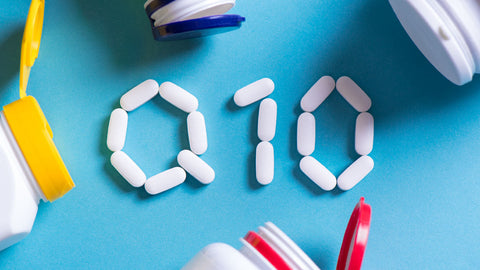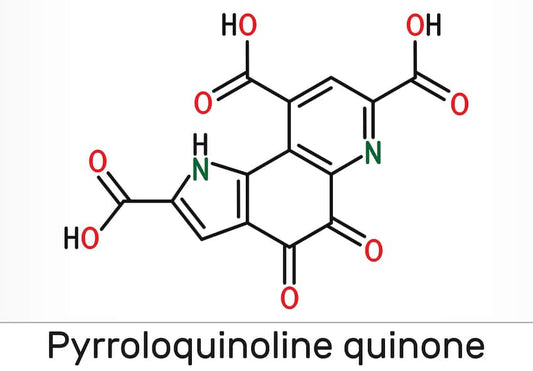Coenzyme Q10, also known as CoQ10, is a vital nutrient for overall health that supports cardiovascular function, cellular energy production, and the body's defenses against oxidative damage.
However, the effectiveness of CoQ10 supplementation can vary quite a bit depending on the timing of intake. This is due to its fat-soluble nature and the way it interacts with the digestive system.
Taking CoQ10 the right way -- including proper timing -- is key to maximizing absorption and ensuring its full potential benefits to the body.
In this guide, we explore best practices of CoQ10 supplementation, including forms, dosages, and when to take CoQ10 for different applications ranging from heart health to pre-workout.
We also share insight on how to integrate CoQ10 into your daily regimen most effectively -- including the best CoQ10 supplement to buy and the best "good fats" that make it work even better. Let's get to it!
Key Takeaways
- CoQ10 (coenzyme Q10) is an energizing antioxidant compound suggested to confer many health benefits when maintained in adequate amounts.
- It is known to support heart health, showing potential to help people with congestive heart failure, high blood pressure and other cardiac concerns.
- It's also an energy supplement. CoQ10 is crucial for mitochondria "powerhouses" of cells, where it helps convert nutrients into energy (ATP).
- The best time to take CoQ10 is typically in the morning or early afternoon, with a meal that contains fats, to enhance its absorption due to its fat-soluble nature.
- Avoid taking CoQ10 late in the day as it may interfere with sleep due to its energy-boosting effects.
- CoQ10 may be taken as a pre-workout supplement to enhance exercise performance. In this case, it should be taken a few hours before a training session.
- You can boost CoQ10 absorption by taking it with piperine, a compound in black pepper extract.
Top CoQ10 Supplement
- Performance Lab® Stim-free energy formula that includes CoQ10 and piperine, plus other natural cell energy boosters. Learn more about Performance Lab® Energy
Healthy Fats to Boost CoQ10 Absorption
- Performance Lab® Omega-3: A clean vegan softgel supplying plant (algae) Omega-3 fatty acids. Learn more about Omega-3
- MCT Energy Oil: Medium-chain triglycerides (MCTs are fats) from organic coconuts, clean processed into pure metabolic performance fuel. Learn more about MCT Energy Oil
What is CoQ10?

Although its structure is very similar to vitamin K, this fat-soluble quinone is not actually a vitamin because it can be synthesized in the body.
It’s a “vitamin-like” compound that’s naturally present in the body in small amounts, most of which is concentrated in the most metabolically active tissues like the heart, lungs, liver, kidneys, spleen, pancreas, and adrenal glands.
The entire body houses relatively little coenzyme Q10—about 500-1,500mg—with levels continuing to decline with age.(1)
That means that if you’re not eating a CoQ10-rich diet, supplementing becomes a must.
But why is this little vitamin-like compound so important? Two big reasons:
1. Our cells can only produce energy if CoQ10 is present.

CoQ10 plays an essential role as an electron transfer molecule that allows for the production of ATP—the fundamental energy substrate used to fuel all cellular processes.(2)
Research has linked low CoQ10 intake to mitochondrial dysfunction. Insufficient production of the ATP energy within the cell's mitochondria powerplants ultimately results in poor cellular function and efficiency.(3)
For its role in supporting increased energy, CoQ10 has been studied for potentially helping many different aspects of health, including chronic fatigue syndrome and the chronic heart failure that is associated with low cardiac energy.(4,5)
2. CoQ10 = Antioxidant Protection Where We Need It Most.

Aside from its role in energy, the other well-known role of CoQ10 is as one of the most powerful antioxidants in all cell membranes (technically in its reduced form, ubiquinol). And it’s the only lipid antioxidant that can be synthesized within the body.(6)
Studies suggest that ubiquinol is equally effective at protecting lipids as alpha-tocopherol (vitamin E), which is considered to be the best lipid-soluble antioxidant available in humans.(7) But the concentration of CoQ10 in cellular membranes can be as much as 30x greater than vitamin E!(8)
CoQ10 antioxidant effects are believed to holistically help human health by reducing the cell-damaging, age-accelerating effects of free radicals.
The Uses Of CoQ10
These two most widely researched bioactivities coenzyme Q10 -- bioenergetics and anti-oxidation -- can promote far-ranging benefits across organs and body systems.
As a result, it's popular in several types of dietary supplements. Some of the most popular CoQ10 applications:
Cardiovascular Health
Coenzyme Q10 (CoQ10) may help heart health in many ways. Its cell energy benefits help to power the heart and regulate heartbeat. CoQ10's antioxidant properties help protect the heart and blood vessels from oxidative damage and inflammation. CoQ10 may also promote blood flow and help with blood clot concerns.
Some research suggests that CoQ10 supplements may even help lower systolic blood pressure and diastolic blood pressure.(9)
*It's important for those with lower blood pressure or who are taking blood pressure medications to consult with a healthcare provider before starting CoQ10. This can help ensure safety and avoid hypotension (very low blood pressure).
Did you know? Cholesterol lowering drugs called statins can deplete the body's CoQ10 stores.(10) For this reason, a healthcare provider, especially complementary and integrative health-oriented doctors, may offer CoQ10 dietary supplements as an add-on to conventional treatments (like statins).
Stim-Free Energy
Coenzyme Q10 (CoQ10) plays a unique role in stimulant-free energy pills and pre-workout supplements, offering a natural boost in energy without caffeine. It is especially favored by those who are sensitive to stimulants or who prefer not to use them due to health reasons. In one systematic review, researchers reported that CoQ10 appears to be a safe and effective way to improve symptoms related to fatigue.(11)
Pre-Workout and Sports Nutrition
CoQ10 may help improve exercise capacity and reduce fatigue, enabling longer and potentially more effective workout sessions for improving muscle strength and overall fitness.(12)
Its cell energy support is perfect for high-demand activities like physical exercise, where efficient energy production can unlock big improvements for performance and endurance. Take it 30-60 minutes before training to improve exercise performance.
CoQ10 antioxidant activity also helps to neutralize free radicals that are generated during intense physical activity. CoQ10 cell protection may potentially reduce fatigue, muscle pain and muscle damage -- allowing for more efficient training sessions and helping to aid recovery.
Learn more about pre-workout supplements
Brain Health and Nootropics
Coenzyme Q10 (CoQ10) is increasingly recognized for its significant role in brain health. CoQ10's ability to enhance energy production is especially important in brain cells, which require a constant and substantial energy supply to function properly and facilitate cognitive processes like memory, thinking, and processing. Clinical trial researchers suggest coenzyme q10 may have potential to both energize the brain and protect it from damage over time.(13)
Learn more about nootropic supplements, foods and drinks
Blood Sugar Support
Coenzyme Q10 (CoQ10) has been studied for its potential role in improving blood sugar control. CoQ10 helps cells convert sugars and fats into energy. This function is particularly important in the context of insulin sensitivity and glucose metabolism. Clinical trials suggests that CoQ10 supplementation may help improve insulin sensitivity and regulate blood sugar levels, especially in diabetic patients.(14)
Related Post: Is Quercetin the Same as CoQ10 and Which is Better?
When and How To Take CoQ10
Nailing supplement timing can be a challenge. Do you take it with food, without food, in the morning, before bed, mid-day? There is no one best way. But some winning strategies for getting the most out of your CoQ10 supplement include:
Take CoQ10 with fat
When we ask, "when is the best time to take coq10," the #1 answer is "with fat." CoQ10 is a fat-soluble nutrient, so for optimal absorption it must be taken with foods or supplements that are source of fats. The best time to take CoQ10 is with a meal. Or alternatively, with a fat-based supplement like Omega-3s or MCT oil.
Learn more about Omega-3 supplements
Learn more about MCT oil supplements
Consider black pepper extract
Clinical research has shown that Coenzyme Q10 (CoQ10) absorption can be significantly improved with the addition of a compound called piperine found in black pepper extract.(15) Advanced CoQ10 supplements will always include black pepper extract to improve absorption.
Take COQ10 as split-doses
Split-dosing CoQ10 throughout the day can enhance its absorption and maintain more consistent levels in the bloodstream, which may optimize its effectiveness. This method also help you avoid the potential waste of a single large dose, ensuring more efficient use of the supplement for sustained energy and antioxidant protection.
How to split-dose CoQ10: Take two or three smaller doses. For example, if you are aiming for a total of 200 mg per day, you might take 100 mg in the morning and another 100 mg in the early afternoon. This schedule helps to maintain optimal levels throughout the day without interfering with sleep at night.
Taking CoQ10 in the morning
Advantageous because it supports cellular energy production throughout the day, enhancing overall vitality and stamina. Additionally, because CoQ10 can have mild stimulating effects, taking it as one big dose in the morning avoids sleep disruption.
Pre-workout: CoQ10 before exercise.
Taking CoQ10 pre-workout can be advantageous as it helps increase energy production at the cellular level, potentially enhancing stamina and endurance during exercise. Additionally, its antioxidant properties may help reduce oxidative stress and muscle fatigue, allowing for more efficient workouts and quicker recovery.
How to use CoQ10 as a pre-workout: When is the best time to take CoQ10 for exercise, specifically? Take CoQ10 (with piperine and fat) about 30 to 60 minutes before a training session. Give your body enough time to absorb the supplement effectively and utilize its benefits during your workout.
Can you take CoQ10 on an empty stomach?
Yes, you can take CoQ10 on an empty stomach, but it may not be absorbed as efficiently as when taken with food, particularly fats. That's why it's generally recommended to take CoQ10 with a meal that contains fat. If you find that taking CoQ10 on an empty stomach causes stomach upset or discomfort, taking it with food might also help to ease these side effects.
Can you take CoQ10 before bed?
Taking CoQ10 before bed is generally considered safe, but it may not be the best idea. CoQ10 is a cell energy booster that can have mild stimulating effects for some people. You don't want that vitality when you're getting ready for sleep. If you are considering taking CoQ10 at night and are concerned about its impact on your sleep, you might want to start by taking it earlier in the day to see how it affects you.
Can you take COQ10 with blood thinners?
Taking CoQ10 supplements could potentially decrease the effectiveness of blood thinners like warfarin and similar medications, leading to an increased risk of blood clot formation. Due to this potential interaction, it's especially important for those who are on blood thinners to consult their healthcare provider before starting CoQ10 supplements.
When is the best time to take CoQ10?
We've discussed some different options on when you can take CoQ10, specific to different needs.
But what about the very best way to take a CoQ10 supplement overall?
While there are many opinions on this topic, our expert recommendation for general CoQ10 supplementation follows.
Take CoQ10 + piperine (black pepper extract) twice daily with healthy fats from foods or supplements.
Here's what this timing looks like for a 200 mg daily dose of CoQ10:
- Take your first dose in the morning: 100 mg CoQ10 + healthy fats supplements (See Performance Lab MCT Energy Oil and Performance Lab Omega-3) as part of a daily morning supplement routine.
- Take your second dose in the early afternoon: 100 mg CoQ10 + healthy fats snack (See Nu:tropic nootropic energy snack bars with plant-based fats). Be sure to take early enough to not impact sleep quality.
Of course, there are many other times you can take CoQ10. But this recommendation is one that will work with pretty much everyone, especially those who are already following an a.m. supplementation routine.
And remember: The best possible way to take COQ10 will always be under the direction of your trusted healthcare professional.
CoQ10 Dosage Notes
- General Wellness: Common dosages range from 30 mg to 200 mg per day.
- Pre-workout: 100-300 mg, 30-60 minutes before working out to energize physical performance
- Energy: 100-200 mg of CoQ10 per day for overall mitochondrial support
- As a nootropic/brain supplement: 100-300 mg daily for clarity and brain protection
- Specific Concerns: For specific conditions like heart failure or hypertension, higher dosages ranging from 200 mg to 400 mg per day are sometimes recommended under medical supervision.
- Age-related Coenzyme q10 Decline: Generally, dosages for this purpose range from 100 mg to 200 mg per day.
CoQ10 supplements are available in various forms, including capsules, softgels, and liquids, each designed to cater to different absorption preferences and dietary needs.
CoQ10 Foods

What if you don't want to take supplements at all? Here's a list of foods that are good sources of Coenzyme Q10 (CoQ10), along with the approximate amount of CoQ10 contained in each serving.
- Beef Heart - About 113 mg per 3 ounces: Beef heart is one of the richest sources of CoQ10 among organ meats.
- Pork Heart - Around 10-24 mg per 3 ounces: Similar to beef heart, pork heart is also high in CoQ10, making it a beneficial option for those looking to increase their intake through diet.
- Chicken Heart - Approximately 9.2 mg per 3 ounces: Chicken heart provides a good amount of CoQ10 and is often more palatable as a regular dietary inclusion for many.
- Liver (Beef, Pork, Chicken) - Roughly 3-4 mg per 3 ounces: Liver from various animals is a nutritious choice, rich in CoQ10 and other essential nutrients.
- Fatty Fish: Mackerel (about 6.75 mg per 3 ounces), sardines (around 2.3 mg per 3 ounces), salmon (about 1.1 mg per 3 ounces).
- Nuts and Seeds: Sesame seeds ( 0.7 mg per ounce), pistachios (0.6 mg per ounce)
- Vegetables: Spinach - Approximately 0.1 mg per cup (cooked). Some vegetables contain a little CoQ10, but animal products are a much richer source.
These amounts can vary based on the source and preparation of the food. Including a variety of these foods in your diet can help increase your CoQ10 intake naturally.
But you may find it challenging to include some of these foods in your diet on a daily basis.
CoQ10 supplements can solve this challenge, but not all of them are great.
Up next, we have the best CoQ10 supplement on the market you can buy.
Best Dietary Supplement with CoQ10

Performance Lab® Energy
Ingredients: CoQ10 (Coenzyme Q10), PQQ (Pyrroloquinoline Quinone), Acetyl-L-Carnitine (ALCAR), Black Pepper Extract (95% piperine), R-Lipoic Acid, 150 mg.
Performance Lab® Energy is a stim-free supplement to maximize cell energy production throughout the body. It works by fueling, boosting, and multiplying and protecting cells’ powerplant mitochondria. This helps cells generate energy more efficiently, and particularly targets organs and tissues with high energy demands, such as the brain and muscles. The ingredients:
- MicroActive® Q10 (CoQ10), 100 mg
- BioPQQ® (Pyrroloquinoline Quinone), 10 mg
- Acetyl-L-Carnitine (ALCAR), 750 mg
- BioPerine® Black Pepper Extract, 2.5 mg
- Bio-Enhanced® R-Lipoic Acid, 150 mg
It's an ideal formula for powering-up mental function, exercise performance, and overall daily vitality without any caffeine or stim-related side effects.
Performance Lab® Energy benefits:
- Revolutionary jitter-free energy: a clean lift with no crash
- Stim-free mitochondria booster raises vitality at a cellular level
- Safe, natural and legal way to revitalize mental performance
- Boosts exercise performance by charging-up brain and muscles
- 100 mg CoQ10 (as MicroActive® Q10) per serving
The most sophisticated stim-free energy booster ever developed, Performance Lab® Energy is a must-have performance supplement for clean, health-centric regimens.
Best for: If you prefer not to take caffeine but still want energy, Performance Lab® Energy is for you. It’s also great for anyone who wants a mix of mental and physical energy, including athletes who take it as a stim-free pre-workout.
Best Healthy Fats to Boost CoQ10 Absorption
If you're following best practices with your CoQ10 supplementation, you will be taking it with some form of fat to optimize its absorption.
But what if you don't feel like having a fatty meal with your CoQ10? You've still got options, that are in fact better. As long as you take fat with CoQ10, why not make it healthy?
We've got two supplements and one functional food bar that supply healthy fats that can boost CoQ10 absorption while supporting your overall wellness.
Performance Lab® MCT Energy Oil

Ingredients: Purified C8+C10 MCTs (medium-chain triglycerides) from 100% organic non-GMO coconuts. Per tablespoon: 8.6 g C8 MCT (Caprylic Acid); 4.2 g C10 MCT (Capric Acid).
Performance Lab® MCT Energy Oil supplies medium-chain triglycerides that work like fast-acting fuel for peak metabolic performance.
This high-quality MCT oil sourced from 100% organic coconuts provides rapid energy, enhances cognitive function, and promotes overall physical and mental performance. The MCTs in this formula can also promote fat breakdown and optimize body composition.
A versatile supplement, MCT Energy Oil can be added to smoothies, coffee, shakes, salad dressings and more. It's an ideal "good fat" to take with coenzyme q10.
Performance Lab® Omega-3

Ingredients: Each serving of vegan-friendly, carrageenan-free NutriGels® supplies 1800 mg algal oil (540 mg DHA [Docosahexaenoic Acid]) and 270 mg EPA (Eicosapentaenoic Acid).
Omega-3s from algae are another great choice if you're looking for a healthy fat to take with CoQ10.
Omega-3 fatty acids are among the most versatile "good fats" for human health, helping the brain, joints, bones, eyes, immune performance and more. But they are often sourced from fish.
Performance Lab® Omega-3 instead supplies Omega-3s from algae -- not fish -- so you get all those great benefits without "fish burps," gastric distress or concerns about toxic contaminants.
Nu:tropic

Ingredients (Apple + Cinnamon bar): Norwegian organic black oats, dates, golden flaxseed, chicory syrup, coconut oil, dried apple & apple juice concentrate, Omega-3, choline, phosphatidylserine (PS), B-Vitamins, Magnesium, Vitamin D3, Cinnamon, Himalayan pink salt
This “convenience snack” is made with brain-healthy foods and infused with top nootropics. Helping you to think quicker, work harder, play better and live smarter. All while satisfying your senses.
And they're also loaded with plant-based good fats from coconut oil, black oats, golden flaxseed and more that help to boost CoQ10 absorption.
All in all, an ideal snack to have with your CoQ10 supplement.
Conclusion
CoQ10 is amazing for supporting optimal health. We've just scratched the surface in this article.
Beyond its potential for heart disease and brain degeneration, CoQ10 may hold promise for helping with migraine headaches, skin health, gum disease and more. But to get any benefit, you'll need to take CoQ10 the right way.
So when is the best time to take coQ10? There are many ways to take CoQ10. But as outlined in this article, there are steps you can take to make it work best.
Start by purchasing high-quality CoQ10 supplements that include piperine (black pepper extract).
Take the recommended dosage. Even better, work together with your doctor to find the ideal dosage for your needs.
How to take CoQ10 is the next hurdle. There's enough science to say that we should take CoQ10 with piperine from black pepper extract and some form of fat, hopefully a healthy fat.
Preference and use determine when best to take CoQ10.
For all-day energy, split doses starting first thing in the morning is a good approach. For pre-workout, take CoQ10 30-60 minutes before training.
You can take CoQ10 anytime, really. Just be aware that some people have trouble sleeping if they take it too close to bedtime.
Far more important than timing is taking CoQ10 with fat and piperine at the right dosage on a daily basis. With consistent intake, you may unlock the many benefits of coenzyme q10.
- R Saini. Coenzyme Q10: The essential nutrient. J Pharm Bioallied Sci. 2011;3(3):466-467.
- FL Crane. Biochemical functions of coenzyme Q10. J Am Coll Nutr. 2001;20(6):591-598.
- Hargreaves IP. Coenzyme Q10 as a therapy for mitochondrial disease. Int J Biochem Cell Biol. 2014 Apr;49:105-11. doi: 10.1016/j.biocel.2014.01.020. Epub 2014 Feb 2. PMID: 24495877.
- Maes M, Mihaylova I, Kubera M, Uytterhoeven M, Vrydags N, Bosmans E. Coenzyme Q10 deficiency in myalgic encephalomyelitis/chronic fatigue syndrome (ME/CFS) is related to fatigue, autonomic and neurocognitive symptoms and is another risk factor explaining the early mortality in ME/CFS due to cardiovascular disorder. Neuro Endocrinol Lett. 2009;30(4):470-6. PMID: 20010505.
- Al Saadi T, Assaf Y, Farwati M, Turkmani K, Al-Mouakeh A, Shebli B, Khoja M, Essali A, Madmani ME. Coenzyme Q10 for heart failure. Cochrane Database Syst Rev. 2021 Feb 3;(2)(2):CD008684.
- CM Quinzii, LC López, J Von-Moltke, et al. Respiratory chain dysfunction and oxidative stress correlate with severity of primary CoQ10 deficiency. FASEB J. 2008;22(6):1874-1885.
- B Frei, MC Kim, BN Ames. Ubiquinol-10 is an effective lipid-soluble antioxidant at physiological concentrations. Proc Natl Acad Sci USA. 1990;87(12):4879-4883.
- M Turunen, P Sindelar, G Dallner. Induction of endogenous coenzyme Q biosynthesis by administration of peroxisomal inducers. Biofactors. 1999;9(2-4):131-139.
- Zozina VI, Covantev S, Goroshko OA, Krasnykh LM, Kukes VG. Coenzyme Q10 in Cardiovascular and Metabolic Diseases: Current State of the Problem. Curr Cardiol Rev. 2018;14(3):164-174.
- Littlefield N, Beckstrand RL, Luthy KE. Statins' effect on plasma levels of Coenzyme Q10 and improvement in myopathy with supplementation. J Am Assoc Nurse Pract. 2014 Feb;26(2):85-90.
- Tsai IC, Hsu CW, Chang CH, Tseng PT, Chang KV. Effectiveness of Coenzyme Q10 Supplementation for Reducing Fatigue: A Systematic Review and Meta-Analysis of Randomized Controlled Trials. Front Pharmacol. 2022 Aug 24;13:883251.
- Gökbel H, Gül I, Belviranl M, Okudan N. The effects of coenzyme Q10 supplementation on performance during repeated bouts of supramaximal exercise in sedentary men. J Strength Cond Res. 2010 Jan;24(1):97-102. doi: 10.1519/JSC.0b013e3181a61a50. PMID: 19644406.
- Matthews RT, Yang L, Browne S, Baik M, Beal MF. Coenzyme Q10 administration increases brain mitochondrial concentrations and exerts neuroprotective effects. Proc Natl Acad Sci U S A. 1998 Jul 21;95(15):8892-7. doi: 10.1073/pnas.95.15.8892. PMID: 9671775; PMCID: PMC21173.
- Liang Y, Zhao D, Ji Q, Liu M, Dai S, Hou S, Liu Z, Mao Y, Tian Z, Yang Y. Effects of coenzyme Q10 supplementation on glycemic control: A GRADE-assessed systematic review and dose-response meta-analysis of randomized controlled trials. EClinicalMedicine. 2022 Aug 3;52:101602.
- Piperine, Black Pepper (Piper nigrum) - Restorative Medicine















